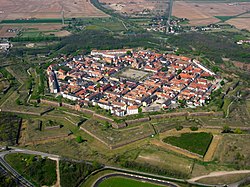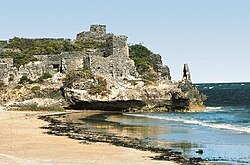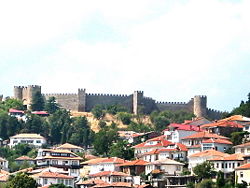
In this seventeenth-century plan of the fortified city of Casale Monferrato the citadel is the large star-shaped structure on the left.

Vauban’s citadel of Neuf Brisach (France)

The Citadel of Aleppo, Syria.

The Citadel of Gondershe, Somalia was an important city in the Medieval Ajuuraan Empire.

A view of Samuil's Fortress, over the old town in Ohrid, Macedonia.

A panoramic view of Moscow Kremlin in 1908
A citadel is a fortress protecting a town, sometimes incorporating a castle.[1] The term derives from the same Latin root as the word "city", civis, meaning citizen.[2]
In a fortification with bastions, the citadel is the strongest part of the system, sometimes well inside the outer walls and bastions, but often forming part of the outer wall for the sake of economy. It is positioned to be the last line of defence should the enemy breach the other components of the fortification system. A citadel is also a term of the third part of a medieval castle, with higher walls than the rest. It was to be the last line of defence before the keep itself.
In various countries, the citadels gained a specific name such as "Kremlin" in Russia or "Alcazaba" in the Iberian Peninsula. In European cities, the term "Citadel" and "City Castle" are often used interchangeably. The term "tower" is also used in some cases such as the Tower of London and Jerusalem's Tower of David. However, the Haitian citadel, which is the largest citadel in the Western Hemisphere, is called Citadelle Laferrière or simply the 'Citadel' in English.
History[]
8000 BCE–600 CE[]
In Ancient Greece, the Acropolis (literally: "peak of the city"), placed on a commanding eminence, was important in the life of the people, serving as a refuge and stronghold in peril and containing military and food supplies, the shrine of the god and a royal palace. The most well-known is the Acropolis of Athens, but nearly every Greek city-state had one - the Acrocorinth famed as a particularly strong fortress. In a much later period, when Greece was ruled by the Latin Empire, the same strongpoints were used by the new feudal rulers for much the same purpose.
167–160 BCE[]
Rebels who took power in the city but with the citadel still held by the former rulers could by no means regard their tenure of power as secure. One such incident played an important part in the history of the Maccabean Revolt against the Seleucid Empire. The Hellenistic garrison of Jerusalem and local supporters of the Seleucids held out for many years in the Acra citadel, making Maccabean rule in the rest of Jerusalem precarious. When finally gaining possession of the place, the Maccabeans pointedly destroyed and razed the Acra, though they constructed another citadel for their own use in a different part of Jerusalem.
3300–1300 BCE[]
Some of the oldest known structures which have served as citadels were built by the Indus Valley Civilization, where the citadel represented a centralised authority. The main citadel in Indus Valley was almost 12 meters tall.[3] The purpose of these structures, however, remains debated. Though the structures found in the ruins of Mohenjo-daro were walled, it is far from clear that these structures were defensive against enemy attacks. Rather, they may have been built to divert flood waters.
500–1500 CE[]
At various periods, and particularly during the Middle Ages, the citadel - having its own fortifications, independent of the city walls - was the last defence of a besieged army, often held after the town had been conquered. A city where the citadel held out against an invading army was not considered conquered. For example, in the 1543 Siege of Nice the Ottoman forces led by Barbarossa conquered and pillaged the town itself and took many captives - but the city castle held out, due to which the townspeople were accounted the victors.
1600–2000 CE[]
As late as the 19th century, a similar situation developed at Antwerp, where a Dutch garrison under General David Hendrik Chassé held out in the city's citadel between 1830 and 1832, while the city itself had already become part of the independent Belgium.
In time of war the citadel in many cases afforded retreat to the people living in the areas around the town. However, Citadels were often used also to protect a garrison or political power from the inhabitants of the town where it was located, being designed to ensure loyalty from the town that they defended.
For example, Barcelona had a great citadel built in 1714 to intimidate the Catalans against repeating their mid-17th- and early-18th-century rebellions against the Spanish central government. In the 19th century, when the political climate had liberalised enough to permit it, the people of Barcelona had the citadel torn down, and replaced it with the city's main central park, the Parc de la Ciutadella. A similar example is the Citadella in Budapest, Hungary.
The attack on the Bastille in the French Revolution - though afterwards remembered mainly for the release of the handful of prisoners incarcerated there - was to considerable degree motivated by the structure being a Royal citadel in the midst of revolutionary Paris.
Similarly, after Garibaldi's overthrow of Bourbon rule in Palermo, during the 1860 Unification of Italy, Palermo's Castellamare Citadel - symbol of the hated and oppressive former rule - was ceremoniously demolished.
The Siege of the Alcázar in the Spanish Civil War, in which the Nationalists held out against a much larger Republican force for two months until relieved, shows that in some cases a citadel can be effective even in modern warfare; a similar case is the Battle of Huế, where an NVA division held the citadel of Huế for 26 days against roughly their own numbers of much better-equipped US and South Vietnamese troops.
2000–Present CE[]
The Citadelle of Quebec (1673–Present) still survives as the largest citadel still in official military operation in North America after more than two hundred years of existence.[citation needed]
[]
On armored warships, the heavily armored section of the ship that protects the ammunition and machinery spaces is called the citadel.
The safe room on a ship is also called a citadel.
See also[]
- Bijela Tabija (English: White Bastion) is a citadel overlooking the historic core of Sarajevo - National monument of Bosnia and Herzegovina
- Citadel Počitelj overlooking the historic village Počitelj and with it constitute architectural whole - National monument of Bosnia and Herzegovina
- Gradačac Castle is a citadel, also a palace of Husein "Dragon Of Bosnia" Gradaščević who was a renowned 19th-century military Bosnian Captain, overlooking the historic core of Gradačac - National monument of Bosnia and Herzegovina
- Bab Ksiba Southern gateway to the Kasbah, Marrakesh, first Citadel to the Sultans of Morocco
- Alcazaba a term for Moorish citadels in Spain
- Casbah/Kasbah a synonym
- Bam citadel/Iran
- Arx (Roman)
- Citadel of Arbil
- Citadella Budapest
- The Citadella, Gozo
- Citadelle Laferrière built by King Henry I of Haiti
- Citadelle le Forcalquier
- Acropolis
- Alcázar
- Acra (fortress)
- Antwerp citadel in 1830-32
- Cadmea
- Citadel of Salah Ed-Din
- Cairo Citadel
- Brest Fortress
- Dublin Castle
- Edinburgh Castle
- El Morro
- Fort Santiago, Manila
- Kremlin
- Palmanova / Palmanova Fortress (Northeastern Italy)
- Prague Castle
- Tower of London
- Tower of David (Jerusalem)
- Kars#Kars Citadel
- Uzhhorod Castle
- Samuil's Fortress, Ohrid
- Spandau Citadel
- Suomenlinna (Finland)
- Icecrown citadel
- Presidio
References[]
- ↑ Sidney Toy (1985). Castles: Their Construction and History. Courier Dover. ISBN 0-486-24898-4.
- ↑ "Citadel". http://en.wiktionary.org/wiki/citadel. Retrieved 4 April 2013.
- ↑ Thapar, B. K. (1975). "Kalibangan: A Harappan Metropolis Beyond the Indus Valley". pp. 19–32.
| Wikimedia Commons has media related to Citadels. |
External links[]
| |||||||||||||||||||||||
The original article can be found at Citadel and the edit history here.